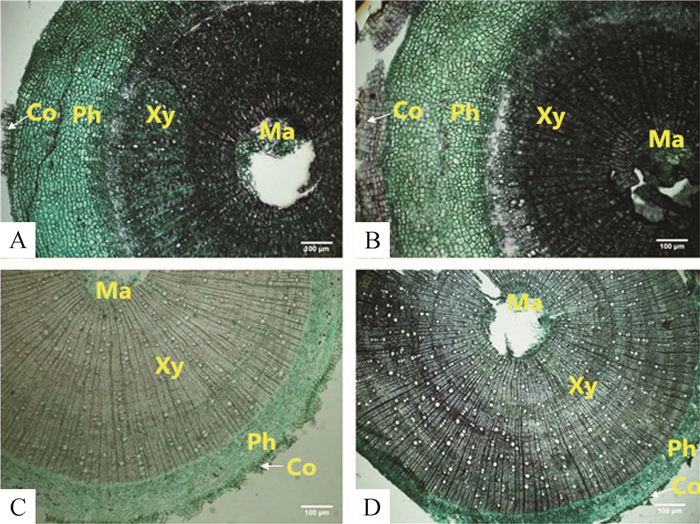Seedling growth, morphology and physiological characteristics of Triadica rotundifolia and Croton lachnocarpus under drought stress
-
摘要:目的
为华南石灰岩地区植被恢复的树种选择及人工造林提供理论依据.
方法应用温室盆栽生长法,通过不同浇水频度控制干旱条件,并用常规方法测定各项指标.
结果和结论在干旱胁迫条件下,圆叶乌桕Triadica rotundifolia和毛果巴豆Croton lachnocarpus的苗高净生长量分别比对照减少2%~5%和8%~10%,基径净生长量增加17%~35%和10%~30%;随着干旱胁迫的加剧,2种植物幼苗的地上部和地下部生物量、根冠比均呈现下降趋势.生理检测结果表明,圆叶乌桕苗木的可溶性蛋白含量、过氧化物酶(POD)活性、超氧化物歧化酶(SOD)活性和丙二醛(MDA)含量均低于毛果巴豆;2种植物苗木的可溶性蛋白含量和POD活性对干旱胁迫的响应比较敏感,但SOD活性和MDA含量对干旱胁迫的响应变化不明显.茎部解剖结构比较结果表明,2种植物在茎部皮层、韧皮部、木质部和髓部比例存在较大的差异,干旱胁迫会导致其木质部与髓部厚度比值增加,反映了2个树种可通过增加木质部与髓部结构来适应干旱胁迫.模糊隶属函数值分析结果表明,无论是轻度干旱,还是中度和重度干旱,圆叶乌桕的耐旱能力均强于毛果巴豆,其生理指标和茎部结构对干旱胁迫响应的不同反映了其耐干旱胁迫机制存在差异.
Abstract:ObjectiveSeedling growth, morphology and physiological characteristics of Triadica rotundifolia and Croton lachnocarpus were investigated under drought stress to provide scientific basis for species selection and artificial reforestation in the limestone region of South China.
MethodPot culture experiment was applied in this study to simulate drought stress by watering frequency.The physiological indicators were measured with comventional methods.
Result and conclusionThe results showed that height growth of T.rotundifolia and C. lachnocarpus declined by 2%-5% and 8%-10% respectivly, while basal diameter growth increased by 17%-35% and 10%-30% respectivly under drought stress. Seedling aboveground biomass, underground biomass, total biomass, and root-shoot ratio could be enhanced by light drought stress, but they declined with the increase of drought stress. Results of physiological examination showed that the soluble protein content, peroxidase (POD) activity, activity of superoxide dismutase (SOD), and malondialdehyde (MDA) content varied with species and drought stress. Soluble protein content and POD activity were more sensitive than the activity of SOD and MDA content. Comparison of the stem anatomical structure showed that there were differences in the structure of cortex, phloem, xylem and marrow. Drought would result in increasing ratio of xylem and marrow, which indicated that they could adapt to drought stress by adjusting xylem and marrow structure. Analyses of subordinate functions showed that the drought tolerance of T.rotundifolia were higher than that of C. lachnocarpus under various drought stresses. They may possess different resistance mechanisms to drought stress based on their difference in physiological responses and stem anatomical structures.
-
-
表 1 2种供试植物的苗木基本情况
Table 1 Seedling sizes of two species for experiments

表 2 2种植物不同干旱处理组苗木的土壤含水量
Table 2 Soil moisture of two species under different drought treatments

表 3 2种植物不同干旱处理组苗木的净生长量比较1)
Table 3 Seedling growth of two species under different drought treatments

表 4 2种植物不同干旱处理组苗木的生物量和根冠比1)
Table 4 Biomass and root shoot ratio of two species under different drought treatments

表 5 2种植物不同干旱处理组苗木茎横切面各部分半径厚度比较1)
Table 5 Comparisons of stem anatomical structure of two species under different drought treatments

表 6 基于模糊隶属函数值对2种植物耐旱性的综合评价
Table 6 Comprehensive assessments of drought tolerance of two species based on subordinate function values

-
[1] 容丽, 王世杰, 俞国松, 等.荔波喀斯特森林4种木本植物水分来源的稳定同位素分析[J].林业科学, 2012, 48(7):14-22. http://d.old.wanfangdata.com.cn/Periodical/lykx201207003 [2] 王发国, 秦新生, 陈红锋, 等.海南岛石灰岩特有植物的初步研究[J].热带亚热带植物学报, 2006, 14(1):45-54. doi: 10.3969/j.issn.1005-3395.2006.01.008 [3] 吴静, 秦飞, 王维, 等.我国石灰岩地区特有植物研究进展[J].江苏林业科技, 2010, 37(2):50-54. doi: 10.3969/j.issn.1001-7380.2010.02.015 [4] CLEMENTS R, SODDHI N S, SCHILTHUIZEN M, et al. Limestone karsts of Southeast Asia: Imperiled arks of biodiversity[J].Bio Sci, 2006, 56(9):733-742. https://academic.oup.com/bioscience/article/56/9/733/262911
[5] ZHU H, WANG H, LI B, et al. Biogeography and floristic affinities of the limestone flora in Southern Yunnan, China[J]. Ann Missouri Bot Gard, 2003, 90(3):444-465. doi: 10.2307/3298536
[6] 韩玉杰, 徐志防, 叶万辉, 等.不同类型喀斯特植物的荧光特征及抗旱性比较[J].广西植物, 2007, 27(6):918-922. doi: 10.3969/j.issn.1000-3142.2007.06.022 [7] 莫凌, 黄玉清, 覃家科, 等.西南喀斯特地区四种植物水分生理的初步研究[J].广西植物, 2008, 28(3):402-406. doi: 10.3969/j.issn.1000-3142.2008.03.028 [8] 张中峰, 黄玉清, 莫凌, 等.岩溶区4种石山植物光合作用的光响应[J].西北林学院学报, 2009, 24(1):44-48. http://d.old.wanfangdata.com.cn/Periodical/xblxyxb200901012 [9] QUEREJETA J I, ESTRADA-MEDINA H, ALLEN M F, et al. Utilization of bedrock water by Brosimum alicastrum trees growing on shallow soil atop limestone in a dry tropical climate[J]. Plant Soil, 2006, 287(1/2):187-197.
[10] QUEREJETA J I, ESTRADA-MEDINA H, ALLEN M F, et al. Water source partitioning among trees growing on shallow karst soils in a seasonally dry tropical climate[J]. Oecologia, 2007, 152(1):26-36. doi: 10.1007/s00442-006-0629-3
[11] WU Z Y, RAVEN P H. Flora of China:Vol.11[M]. Beijing:Science Press, 1999:284. http://d.old.wanfangdata.com.cn/OAPaper/oai_doaj-articles_705352a9b0cc17379072a697a986f5e7
[12] 张宏达, 丘华兴.值得注意的中国植物:续二[J].广西植物, 2003, 23(2):97-101. doi: 10.3969/j.issn.1000-3142.2003.02.001 [13] 李合生.植物生理生化实验原理和技术[M].北京:高等教育出版社, 2001. [14] 庄丽, 陈亚宁, 陈明, 等.模糊隶属法在塔里木河荒漠植物抗旱性评价中的应用[J].干旱区地理, 2005, 28(3):367-372. doi: 10.3321/j.issn:1000-6060.2005.03.019 [15] 贺少轩, 梁宗锁, 蔚丽珍, 等.土壤干旱对2个种源野生酸枣幼苗生长和生理特性的影响[J].西北植物学报, 2009, 29(7):1387-1393. doi: 10.3321/j.issn:1000-4025.2009.07.015 [16] 杨玉珍, 贾遂民, 彭方仁.干旱胁迫对不同种源香椿苗木生长的影响[J].林业科技开发, 2009, 23(6):52-55. doi: 10.3969/j.issn.1000-8101.2009.06.013 [17] 刘锦春, 钟章成.水分胁迫和复水对石灰岩地区柏木幼苗根系生长的影响[J].生态学报, 2009, 29(12):6439-6445. doi: 10.3321/j.issn:1000-0933.2009.12.016 [18] 邹琦, 李德全, 郑国生, 等.作物抗旱生理生态研究[M].济南:山东科学技术出版社, 1994:24-29. [19] 时忠杰, 杜阿朋, 胡哲森, 等.水分胁迫对板栗幼苗叶片活性氧代谢的影响[J].林业科学研究, 2007, 20(5):683-687. doi: 10.3321/j.issn:1001-1498.2007.05.016 [20] 谢志玉, 张文辉, 刘新成.干旱胁迫对文冠果幼苗生长和生理生化特征的影响[J].西北植物学报, 2010, 30(5):948-954. http://d.old.wanfangdata.com.cn/Periodical/xbzwxb201005015 [21] 何开跃, 李晓储, 黄利斌, 等.干旱胁迫对木兰科5树种生理生化指标的影响[J].植物资源与环境学报, 2004, 13(4):20- 23. doi: 10.3969/j.issn.1674-7895.2004.04.005 [22] 徐利霞. 石漠化山区造林树种幼苗的抗旱性研究[D]. 重庆: 西南大学, 2007. [23] 李霞, 阎秀峰, 于涛.水分胁迫对黄檗幼苗保护酶活性及脂质过氧化作用的影响[J].应用生态学报, 2005, 16(12):2353-2356. doi: 10.3321/j.issn:1001-9332.2005.12.025




 下载:
下载:

